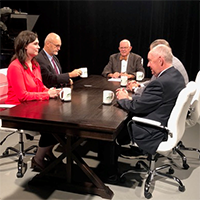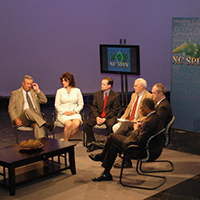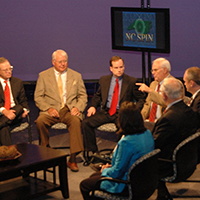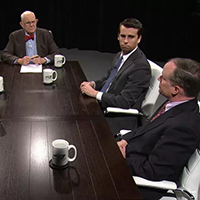State courts head into 2015 budget session stripped to the bone
Published January 17, 2015
by Sharon Mccluskey, NC Policy Watch, January 14, 2015.
At just about this time last year, John Smith, the director of the Administrative Office of the Courts, approached state lawmakers hat in hand with modest requests for court funding.
His budget had been slashed repeatedly since the recession, and Smith knew it would likely be a target once again as the General Assembly went into the short session.
The court system was teetering on the brink, and despite the fact that it still had collected more than $800 million in fees, fines and penalties that would be distributed elsewhere across the state, Smith asked only for a long overdue restoration of pay plans and steps for clerks and magistrates and roughly $2 million for technology initiatives.
What he got, instead, was another $2.9 million cut to the AOC budget and an additional $500,000 reduction to technology appropriations.
And that was a good result, given the drastic cuts lawmakers had proposed.
As 2014 wound down, court deficits became an embarrassment.
In Mecklenburg County, for example, court officials predicted a shortfall in funds to pay jurors there, according to this report in the Charlotte Observer.
The county’s own senators professed ignorance when asked about that situation and promised to make the courts a priority once money became available.
“The courts are a priority to us,” Sen. Bob Rucho said at the time. “When we get our financial house in order, these are the areas that the state should be taking responsibility for first.”
To courthouse veterans, though, promises of better days ahead were a tired refrain.
“The courts in North Carolina have never, and I underline ‘never,’ been completely funded, and it’s only gotten worse in the last 10 years,” former Mecklenburg presiding superior court judge Richard Boner told the Observer. Boner retired at the end of the 2014 after 27 years on the bench.
“The courts are being starved.”
But as the new session opens, the newly installed Chief Justice, Mark Martin, hopes to change the conversation with lawmakers and improve the treatment courts receive on Jones Street.
“Our founders clearly understood the importance of our courts, and that is why they made the courts a separate and co-equal branch of government; a co-equal branch which has a critical function to perform on behalf of the people of North Carolina,” Martin said in remarks after his swearing-in last week.
“That function requires adequate resources, and my top goal as Chief Justice will be working to strengthen our courts through adequate funding and efficient administration.”
***
By the 2014 short session, the AOC had already met budget cuts by eliminating more than 600 court positions through attrition, voluntary reductions-in-force programs, and involuntary layoffs, and deferring the hiring for nearly 700 positions determined to be essential under workload formulas developed in consultation with the National Center for State Courts.
Funding for court technology had also been slashed by 40% over the past three years, from $45 million in 2011 to $27 million in 2014, “crippling statewide implementation of existing piloted technology and choking off adoption of new technology,” according to the director.
The governor’s proposed budget then appropriated sufficient funds to cover AOC requests.
Lawmakers, though, wanted deeper cuts.
The Senate had proposed cutting technology funding to the courts by $3.7 million and the remaining AOC administrative appropriation by an additional $1.5 million. The House had called for a flat $4.95 million AOC cut and proposed gutting budgets for Family Courts.
In the end the AOC had to settle with nearly a $3 million budget cut and another $500,000 strip off the technology budget – which combined went to reducing salary reserves and cutting funds for IT equipment and eliminating IT positions.
Ongoing cuts have left court personnel scrambling and attorneys scratching their heads.
“For some reason that is not entirely clear to me, the legislature does not seem to feel a need for significant funding for the courts,” North Carolina Bar Association President Catharine Arrowood said in a July interview with Policy Watch.
“I hear a lot of chatter about lazy judges, things like that. It’s really an educational problem. I think there’s a lack of understanding about how hard judges work, and the role that the courts play in our society. The courts are the third branch of government.”
***
Martin made the strength of the courts a campaign issue as he crossed the state this past fall, vetting a seven-point plan he developed along the way.
Among those points:
- Improving systems to strengthen the courts – including having the Supreme Court take more cases and issue more opinions
- Working with state lawmakers and the National Center for State Courts to develop new court funding strategies
- Getting electronic filing up and running in all state courts
- Educating state residents and lawmakers about the role of the courts as a co-equal branch of state government
- Creating public and private partnerships to establish mental health resources in the justice system
- Increase court transparency and accountability to the public
With that plan, he’ll now set out to bridge differences with lawmakers and convince them that the court system deserves the respect and funding it deserves as a branch of government.
The devil is in the details, of course, and much of what Martin hopes to accomplish requires money, which will be tough to find in 2015, given the state’s revenue shortfall.
But at least at this early stage, reaction has been positive. AOC director John Smith said in a statement that he “fully supports the needs and directions that the Chief Justice has outlined in his plan.”
And Catharine Arrowood told he News and Observer that the Bar Association will work with Martin to find more money for the courts.
January 19, 2015 at 8:23 am
Frank Burns says:
It would be my proposal to tax lawyers to pay for the court system. After all they are part of the problem with frivolous lawsuits and fraud being part of their toolbox.







